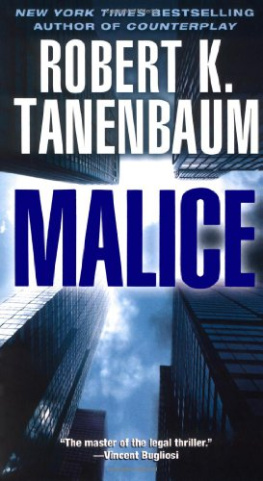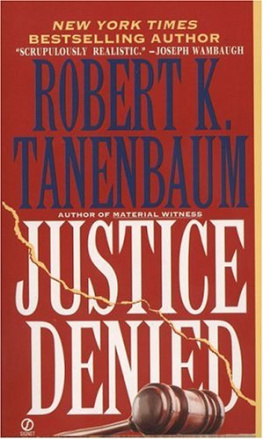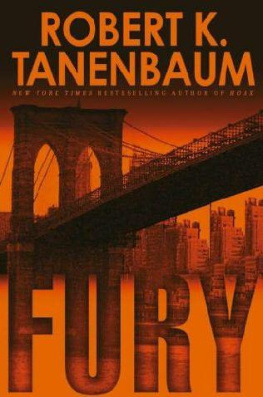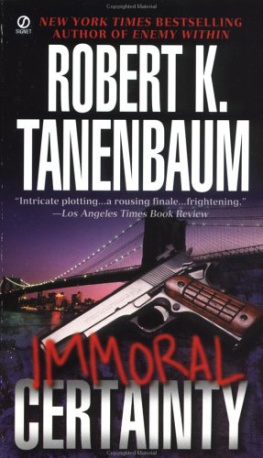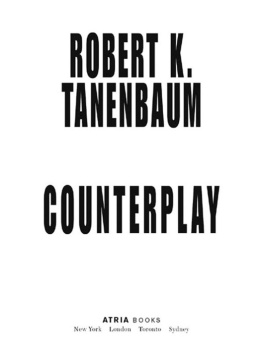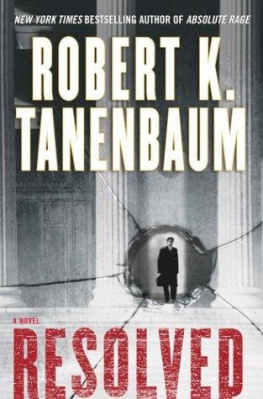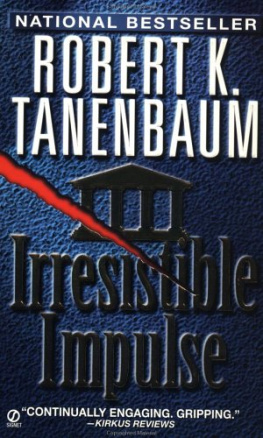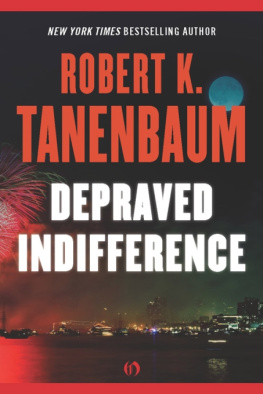Robert K. Tanenbaum - Malice
Here you can read online Robert K. Tanenbaum - Malice full text of the book (entire story) in english for free. Download pdf and epub, get meaning, cover and reviews about this ebook. year: 2007, publisher: Simon and Schuster, genre: Detective and thriller. Description of the work, (preface) as well as reviews are available. Best literature library LitArk.com created for fans of good reading and offers a wide selection of genres:
Romance novel
Science fiction
Adventure
Detective
Science
History
Home and family
Prose
Art
Politics
Computer
Non-fiction
Religion
Business
Children
Humor
Choose a favorite category and find really read worthwhile books. Enjoy immersion in the world of imagination, feel the emotions of the characters or learn something new for yourself, make an fascinating discovery.
- Book:Malice
- Author:
- Publisher:Simon and Schuster
- Genre:
- Year:2007
- Rating:4 / 5
- Favourites:Add to favourites
- Your mark:
- 80
- 1
- 2
- 3
- 4
- 5
Malice: summary, description and annotation
We offer to read an annotation, description, summary or preface (depends on what the author of the book "Malice" wrote himself). If you haven't found the necessary information about the book — write in the comments, we will try to find it.
Malice — read online for free the complete book (whole text) full work
Below is the text of the book, divided by pages. System saving the place of the last page read, allows you to conveniently read the book "Malice" online for free, without having to search again every time where you left off. Put a bookmark, and you can go to the page where you finished reading at any time.
Font size:
Interval:
Bookmark:
Counterplay
Fury
Hoax
Resolved
Absolute Rage
Enemy Within
True Justice
Act of Revenge
Reckless Endangerment
Irresistible Impulse
Falsely Accused
Corruption of Blood
Justice Denied
Material Witness
Reversible Error
Immoral Certainty
Depraved Indifference
No Lesser Plea
The Piano Teacher: The True Story of a Psychotic Killer
Badge of the Assassin
A Division of Simon & Schuster, Inc.
1230 Avenue of the Americas
New York, NY 10020
This book is a work of fiction. Names, characters, places, and incidents are products of the authors imagination or are used fictitiously. Any resemblance to actual events or locales or persons, living or dead, is entirely coincidental.
Copyright 2007 by Robert K. Tanenbaum
All rights reserved, including the right to reproduce this book or portions thereof in any form whatsoever. For information address Atria Books Subsidiary Rights Department, 1230 Avenue of the Americas, New York, NY 10020
Library of Congress Cataloging-in-Publication Data is available
ISBN-13: 978-1-4165-4650-4
ISBN-10: 1-4165-4650-2
ATRIA BOOKS and colophon are trademarks of Simon & Schuster, Inc.
Visit us on the World Wide Web:
http://www.SimonSays.com
To those most special, Patti, Rachael, Roger, and Billy; and to my legendary mentors, Coach Paul Ryan, Coach Rene Herrerias,
District Attorney Frank S. Hogan, and Henry Robbins
Wendy Walker and Espey Jackson deserve special recognition for their invaluable assistance. The superior quality of the manuscript is directly attributable to their devoted and brilliant contributions.
November 17, 1603
Westminster, England
T HOU ART A MONSTER! T HE PROSECUTOR ROARED OUT HIS accusation and pointed at the defendant as the judges and jurors in their satin doublets and embroidered waistcoats shifted uneasily in their seats. Thou hast an English face but a Spanish heart!
The defendant, Sir Walter Raleigh, remained calm despite the worst insult to someone who had spent much of his life fighting against Spain. But, forty-nine years old, his hair and the distinctive goatee shot through with gray, he now stood accused of treason.
Let me answer for myself, Raleigh demanded.
Thou shalt not, Prosecutor Sir Edward Coke thundered back.
Raleigh turned to the jury. It concerneth my life, he pleaded, though he knew the men before him were not sympathetic to him personally or interested in a fair trial.
The hearing was a specialized sort of court procedure. In later years, it would be inaccurately referred to as a Star Chamber, a fifteenth-to seventeenth-century English court comprised of judges appointed by the Crown. The Star Chambers, so named because the courtrooms were decorated with stars, were notorious for being conducted in secrecy and were given to arbitrary procedures. They were a convenient way for the Crown, and its supporting nobles, to get rid of rivals and enemies both real and perceived.
What Raleigh faced was actually a special commission of oyer and terminer. Similar to the Star Chambers, the commissions had been created for the sole purpose of trying people accused of treason. However, unlike a Star Chamber, juries sat on these commissions and weighed what evidence was presented to them. The trials were also supposed to be governed by the rules of law, and the proceedings were followed with great interest by the general public. However, the method and outcome were still heavily weighted in favor of the Crowns wishes.
The prosecutor, Sir Edward Coke, would someday be noted in legal circles as a man of substantial courage who in his waning years actually stood up to the Crown on behalf of English common law, which would become the basis of the American legal system. But at this time, he was not well liked by the general public because of his involvement two years earlier in convicting the popular Lord Essex of treason on orders of Queen Elizabeth. On the other hand, Raleigh was not universally liked by the common man either.
Soldier, ships captain, adventurer, poet, and courtier, Raleigh was one of the most famous men of his time in both his own country and among Englands enemies, especially Spain, whose treasure ships from the New World hed plundered on behalf of his Queen and himself. He was also one of the wealthiest men in England.
With his taste for fine clothes and armed with charm and wit, he made a dashing knight in Elizabeths courtwith a reputation as a ladies manand occupied a special place in the heart of the Queen. Legend had it that he had once laid his cloak over a mud puddle so that Elizabeth would not have to dirty her royal feet. But it was his charms with the ladies that also got him in trouble with Her Majesty when he married one of her maids of honorthe lovely, and much younger, Bess Throckmortonwithout the Queens permission. The Queen had him thrown into the Tower of London, but she eventually relented when she realized that the couple truly were in love.
Her Majestys court was notorious for its intrigues and plots, with the various courtiers vying against one another for the position as her favorite. Lord Essex, Robert Devereux, a descendant of King Henry VIII, had been one of Raleighs chief rivals.
Devereux was a hero to the masses for his military successes against the Spanish and also a favorite of the Queen. However, he saw himself as deserving of the throne and was accusedwith reasonof conspiring against her with King James VI of Scotland.
Tried by Coke, Devereux was convicted and executed in February 1601. It was this execution that also would cast Raleigh in a bad light with the public. Although he had nothing to do with the trial, he held the title of Sheriff of London, which meant that he had the duty of presiding over the execution. The public saw this as a devious way to remove a rival, and he was reviled for it.
In 1603, Raleighs fortunes took a definitive turn for the worse when the Queen died. Soon thereafter, none other than King James ascended to the throne. And not long after that Raleigh was himself arrested for treasonaccused of plotting with his friend Lord Cobham and with Spain against James.
When the trial began that morning, Coke was faced with a dilemma; he had very little evidence, only an unsigned letter supposedly written by Cobham that accused Raleigh of being part of the conspiracy. On the other hand, the commissions of oyer and terminer were not known for their objectivity. The judges were selected from officers of the statenobles and judges appointed by the King and his councillors, all with a stake in the survival of the current political structure, and therefore antagonistic toward anyone who might be a threat to the King or their positions.
There was no attempt at impartiality for Raleighs trial. The commissioners, or judges, included Secretary of State Sir Robert Cecil, Sir William Waad, who was Raleighs jailer, the Earls of Suffolk and Devonshire, Lord Wotton, Lord Henry Howard, and Sir John Stanhope, many of whom disliked Raleigh and had envied his status with Elizabeth, or held him partly responsible for Essexs death. They sat with the Chief Justice of the Kings Bench, Sir John Popham, who hated Raleigh, as well as the Chief Justice of the Court of Common Pleas, Sir Edmund Anderson, and Justices Gawdy and Warburton.
The jury was handpicked in advance. Comprised of four knights, four esquires, and four gentlemen, this deck of Kings men, too, was stacked against the accused. Yet, when offered the chance to challenge the seating of any juror, Raleigh shook his head. I know none of them, but think them all honest and Christian men. I know my own innocency and therefore will challenge none.
Font size:
Interval:
Bookmark:
Similar books «Malice»
Look at similar books to Malice. We have selected literature similar in name and meaning in the hope of providing readers with more options to find new, interesting, not yet read works.
Discussion, reviews of the book Malice and just readers' own opinions. Leave your comments, write what you think about the work, its meaning or the main characters. Specify what exactly you liked and what you didn't like, and why you think so.

